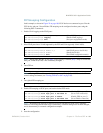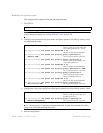BLADEOS 6.5.2 Application Guide
206 Chapter 14: FCoE and CEE BMD00220, October 2010
Priority Groups
For ETS use, each 801.2p priority value is assigned to a priority group which can then be allocated
a specific portion of available link bandwidth. To configure a priority group, the following is
required:
CEE must be turned on (“Turning CEE On or Off” on page 192) for the ETS feature to
function.
A priority group must be assigned a priority group ID (PGID), one or more 802.1p priority
values, and allocated link bandwidth greater than 0%.
PGID
Each priority group is identified with number (0 through 7, and 15) known as the PGID.
PGID 0 through 7 may each be assigned a portion of the switch’s available bandwidth.
PGID 8 through 14 are reserved as per the 802.1Qaz ETS standard.
PGID 15 is a strict priority group. It is generally used for critical traffic, such as network
management. Any traffic with priority values assigned to PGID 15 is permitted as much bandwidth
as required, up to the maximum available on the switch. After serving PGID 15, any remaining link
bandwidth is shared among the other groups, divided according to the configured bandwidth
allocation settings.
All 802.1p priority values assigned to a particular PGID should have similar traffic handling
requirements. For example, PFC-enabled traffic should not be grouped with non-PFC traffic. Also,
traffic of the same general type should be assigned to the same PGID. Splitting one type of traffic
into multiple 802.1p priorities, and then assigning those priorities to different PGIDs may result in
unexpected network behavior.
Each 802.1p priority value may be assigned to only one PGID. However, each PGID may include
multiple priority values. Up to eight PGIDs may be configured at any given time. However, no more
than three ETS Priority Groups may include priority values for which PFC is disabled.


















